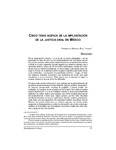| dc.description.abstract | En la imaginación popular —y en la de no pocos abogados— se ha generado la idea de que con la implementación de la justicia oral en los juicios penales, éstos serán desarrollados en presencia del público y frente a un juez impasible (quizás togado) que desde el estrado vea y sancione todos y cada uno de los actos procesales; decida las cuestiones que se vayan presentando; a veces llame a las partes para dialogar e incluso en ocasiones utilice el gavel (martillo) para pedir orden a los presentes —incluyendo al expectante público—; luego, al final, sin mayores trámites, pronuncie una sentencia de fondo que deje satisfecha a la concurrencia. Este parece ser el ejemplo a seguir o cuando menos lo que de él se ha difundido. Frente a esta versión idílica de lo que pudiera ser la administración de la justicia penal mexicana no hay objeción alguna: pública, transparente, segura, concentrada, cercana al juzgador y acaso pronta. Sin embargo, la cuestión no se advierte así de simple. Con vista a nuestra propia experiencia y a la de Estados Unidos a quien presuntamente tratamos de imitar, habría que analizar con cierto cuidado algunas de las proposiciones o tesis que, según parece, ya han sido resueltas satisfactoriamente en torno a este tema. Desde nuestra perspectiva, esas tesis son las siguientes: Es necesario instituir la justicia oral en México; los juicios orales son un reclamo popular; los juicios orales aseguran la transparencia y evitan la corrupción; los juicios orales garantizan la inmediatez con el juzgador; los juicios orales son más rápidos y seguros que los escritos. /
In the popular imagination —and not in a few lawyers— the implementation of oral justice in the criminal process has generated the idea that these will be developed in the presence of an audience and before an impassive judge (perhaps wearing a gown) who, from the platform could see and penalize each and every act during the process; decide side issues presented; sometimes call parties in order to establish a dialogue, or even use the gavel to ask for order to those presents —including the audience—; then, in the end, and with no further formalities, pronounce a sentence which leaves the concurrence satisfied. This may seem the example or at least, what has been spreaded. Opposite to this idyllic version of what would the mexican administration of penal justice could be, there is no objection: public, clear, safe, focused near to the judge and perhaps sudden. Nevertheless, the ma tter is not that simple. With a view to our own experience and the United States', who allegedly the mexican system is trying to follow, we would have to carefully analize some of the propositions or thesis which, it seems, have been solved satisfactory about this topic. From our perspective, this thesis are the following: It is necessary to institue oral proceedings in Mexico; oral trials are a popular claim; oral trials secure clearness and avoid corruption; oral trials guarantee immediacy before the judge; oral trials are faster and safer than the written. | es_MX |







